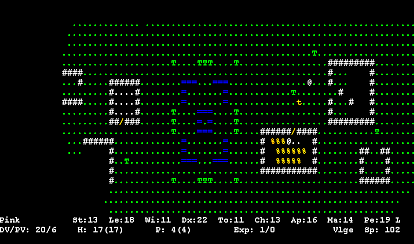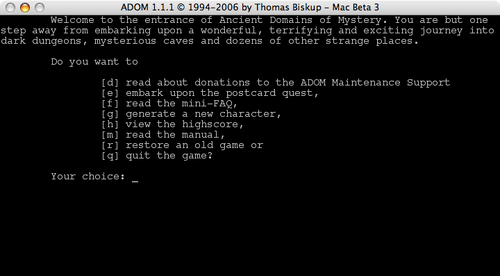
The starting village of ADOM
ADOM (short for Ancient Domains of Mystery) is a roguelike game in which your aim is to stop the forces of Chaos which are invading the world of Ancardia. Like most roguelike games, ADOM uses ASCII graphics to represent the game world.
The player can create their character as male or female, any of ten races and any of twenty character classes, giving 400 possible combinations requiring widely varying playing styles. During adventures, a player is likely to explore many different dungeons and complete multiple quests. Which quests the player chooses will likely depend on their character and on whether they are lawful or chaotic. The alignment of a player also effects which benefits (or curses) their god may bestow upon them, and how they are treated by NPCs. ADOM has a quest-centric, plot driven structure that borrows as much to old adventure games such as Zork (indeed, there are even Grue references to be found) as it does to the "purer" hack-and-slash of sister games such as Angband.
ADOM was written by Thomas Biskup, is currently at version 1.1.1 and can be downloaded from the official site. Although ADOM is freeware (technically postcardware), unlike most roguelikes, its source code is not available. However, some of the game's underlying equations and mechanics have been deduced via careful experimentation by players.
Biskup did not release the source because:
- He wants to keep a level of mystery regarding exactly what the game does.
- He does not want lots of unsanctioned variants spread around, like with Angband.
- He plans to someday release a commercial version of ADOM.
Dungeons
ADOM has an overworld and multiple dungeons. On DOS and Linux, you launch ADOM from the command line into your text-only DOS or terminal window; thus ADOM must draw itself using text in the tradition of Rogue. Each dungeon level fits within the size of the screen, however ADOM will generate larger levels for those with bigger screens, to the extent that ADOM fails to open a saved game if you use a different window size. (In contrast, Rogue confines itself to a grid of 80 by 24 characters, even if you make yourself a larger xterm or DOS window, while Angband creates large levels that scroll off the screen.)
As is usual for roguelike games, ADOM randomly-generates its dungeons. Die and start a new game, and you will find different and unfamiliar dungeon levels (in the same places on the overworld). However, as long as the player's character stays alive, dungeons use persistent levels (as they do in Hack). If the hero leaves a dungeon level and returns later, the same level reappears. Save files contain all dungeon levels already visited.
The dungeon tends to contain rooms, hallways, and doors, but can also have special features such as shops. Stairs connect adjacent levels.
Characters
There are four steps to creating a new character for starting a new game.
- ADOM randomly chooses your birthday. This has some effects.
- You choose the gender, race, and class of the character, or let ADOM make a random choice.
- You can let ADOM adjust the stats randomly, or you can answer multiple-choice questions to adjust the stats.
- You select a number of talents for the new character. The number of talents depends on several factors, with a base of one, and additional talents from other areas. For example, some birth-months (see #1) give you an extra talent. Some classes get extra talents, and if the sum of your attributes is divisible by 7, you get an extra talent.
As you gain experience points by slaying monsters, you will level up, allowing you to boost three skills, and at times, to add new talents.
Controls
ADOM uses the "numpad" method; one uses the numbers 1 through 9 on the numeric keypad to move in eight directions. For players who have keyboards without a numpad, especially laptop keyboards, this can be difficult. There is no option to use "yuhjklbn" control as in Rogue.
As in other roguelike games, one can attack a monster in melee by trying to move onto its square.
In ADOM, one uses the inventory screen to wear and remove equipment. One presses [i] to access the inventory screen, then presses the letter of a slot to equip or remove an item. From the inventory screen, pressing [v] reaches the "stuff" screen, equivalent to the inventory screen in Angband.
Screenshots
Apple Macintosh

The title screen of the Macintosh version.

The main menu.

Gameplay starts in the overworld. As in other roguelike games, the @ symbol represents the hero. In the above screenshot, the hero has followed a road toward the village of Tarinyo o. Most of the map is dark because the hero has not explored it.

Tarinyo after the hero explores town.

Here, orcs o have ambushed the hero @ in the overworld outside of town.

The hero has found a dungeon entrance * southeast of Tarinyo o.

Exploration of a dungeon level. Here, the brown slash / represents an open door and the brown [ is an item on the floor.

The hero has explored most of the level. If the hero returns later, then the level will be the same. However, in other games, a different randomly-generated level will be here.
DOS

The title screen of the DOS version; gameplay is the same on all platforms.

The stats of one hero after leveling up a few times.

Archery; the arrow will travel through the yellow * squares before hitting the jackalwere under the yellow X. Behind the jackalwere are some jackals d.
Game data
Amiga (68k, PowerPC)
- Published by Jochen Terstiege worldwide:
- Version 1.1.1 at 23 November 2002
- Version 1.0.0
- Older versions: 0.9.9 Gamma 15, 0.9.9 Gamma 10, 0.9.9 Gamma 8, 0.9.9 Gamma 6, 0.9.9 Gamma 4
Apple Macintosh (PowerPC, Intel)
- Published by Jochen Terstiege worldwide:
- Version 1.1.1 beta 5 at 27 January 2008
- Version 1.1.1 beta 4 at 10 September 2006
- Version 1.1.1 beta 3 at 25 May 2006
- Version 1.1.1 beta 2 at 6 March 2006
- Version 1.1.1 beta 1 at 5 March 2006
BeOS
- Published by Jochen Terstiege worldwide:
- Version 1.0.0
- Version 0.9.9 Gamma 15
DOS
- Published by Thomas Biskup worldwide:
- Version 1.1.1
- Older versions: 1.1.0, 1.0.0, 0.9.9 Gamma 15, 0.9.9 Gamma 14, 0.9.9 Gamma 13, 0.9.9 Gamma 12, 0.9.9 Gamma 11, 0.9.9 Gamma 10, 0.9.9 Gamma 9, 0.9.9 Gamma 8, 0.9.9 Gamma 7, 0.9.9 Gamma 6, 0.9.9 Gamma 5, 0.9.9, 0.9.4 Gamma 4, 0.9.2, 0.8.4, 0.8.0, 0.7.1, 0.2.0
Java
Unreleased, but JADE "Java-based Ancient Domains Engine" is under development.
Microsoft Windows
This is the native Windows port; one can also use the DOS version.
- Published by Jochen Terstiege worldwide:
- Version 1.1.1 beta 4
- Version 1.1.1 beta 3
Unix (Linux x86)
- Published by Thomas Biskup worldwide:
- Version 1.1.1
- Older versions: 1.1.0, 1.0.0, 0.9.9 Gamma 15, 0.9.9 Gamma 14, 0.9.9 Gamma 13, 0.9.9 Gamma 12, 0.9.9 Gamma 10, 0.9.9 Gamma 9, 0.9.9 Gamma 8, 0.9.9 Gamma 6, 0.9.9, 0.9.4 Gamma 4
- Older versions in a.out, not ELF: 0.9.9 Gamma 9, 0.9.9 Gamma 8, 0.9.9 Gamma 6, 0.9.9, 0.9.4 Gamma 4, 0.8.4, 0.8.0, 0.7.1
JADE
JADE is Thomas Biskup's new roguelike game project. According to present knowledge, it is being developed with the Java programming language, will be open source, and will feature a larger and richer game world than its indirect predecessor, ADOM. More information is available on the official ADOM website.
External links
- The ADOM official site
- The ADOM Guidebook, with detailed spoilers
- Jochen Terstiege's ADOM ports page
- rec.games.roguelike.adom FAQ
- RGRA at Google Groups
- The JADE development page
This article uses content from Wikipedia. The original aricle can be found at Ancient Domains of Mystery. The list of authors can be seen in the page history. As with Codex Gamicus, the text of Wikipedia is available under the Creative Commons Attribution-Share Alike 3.0 (unported) license. |






